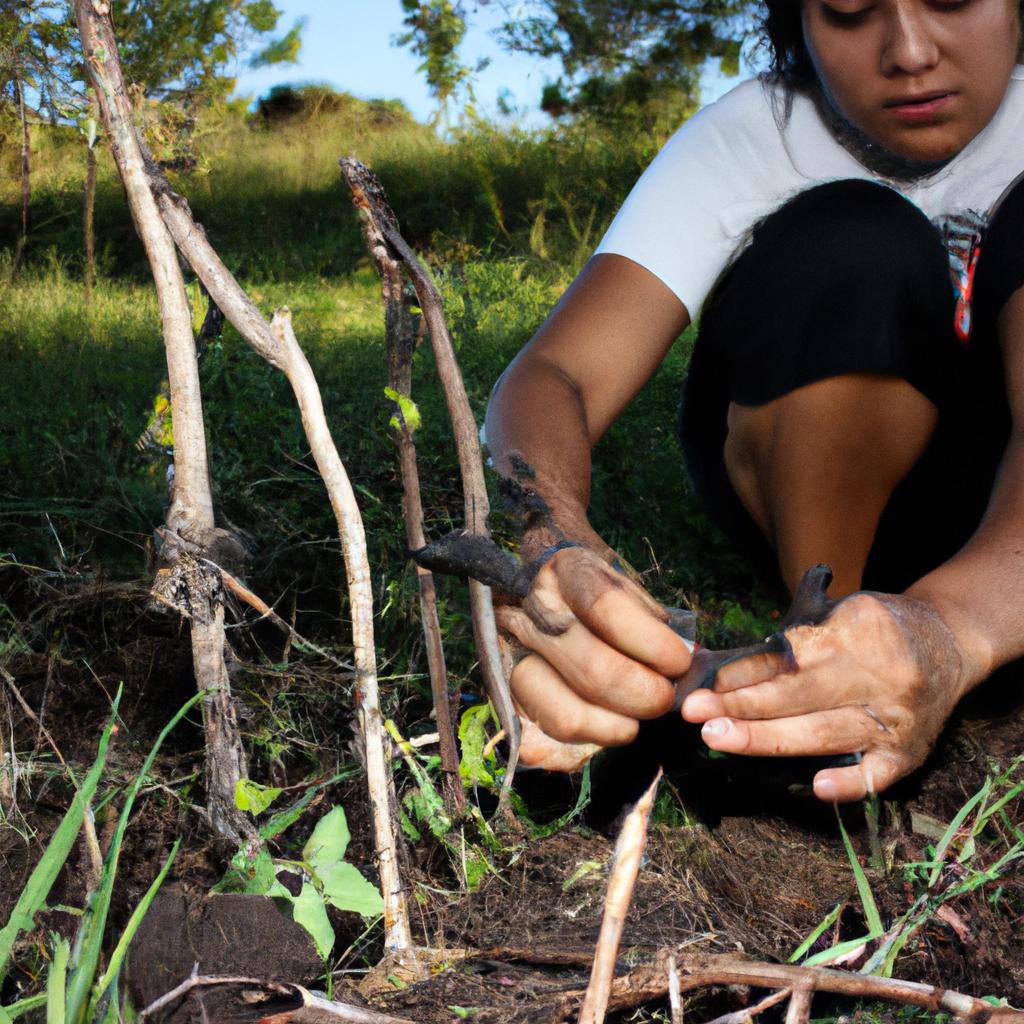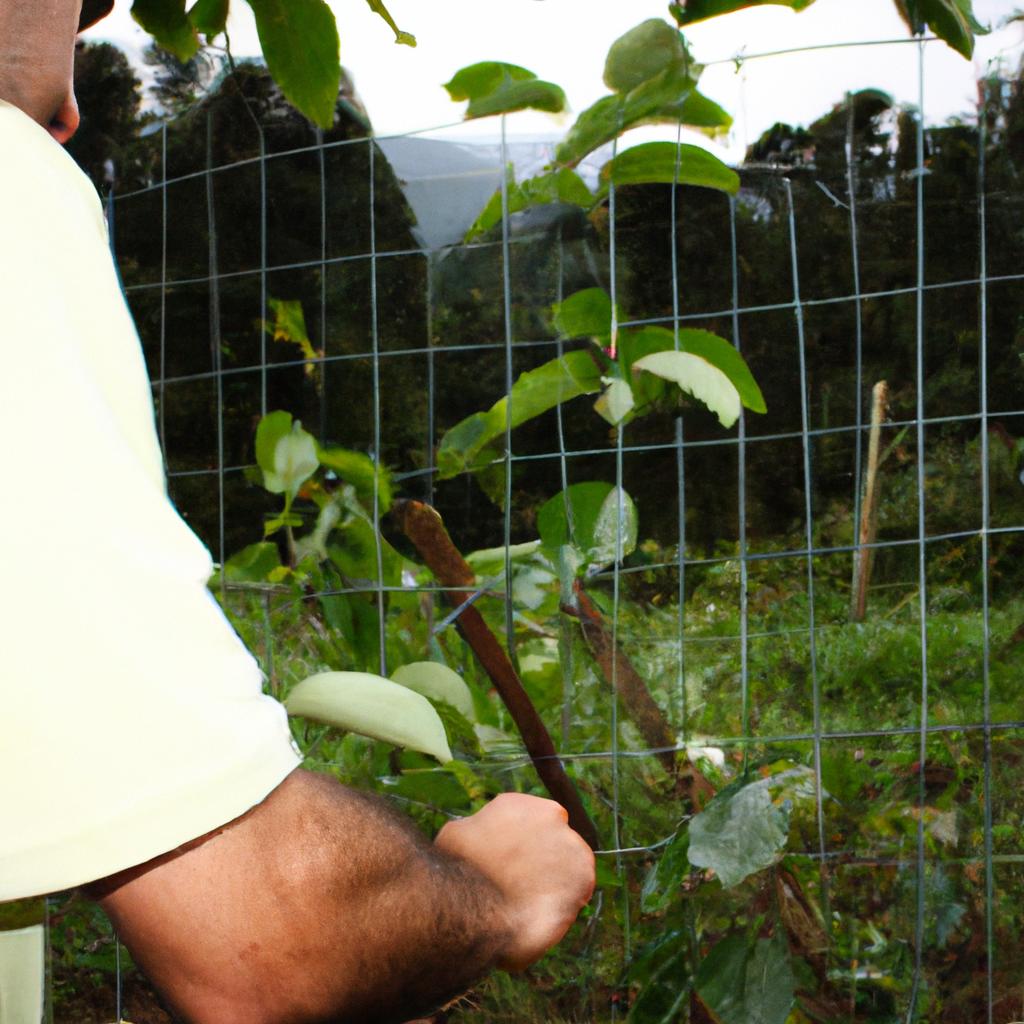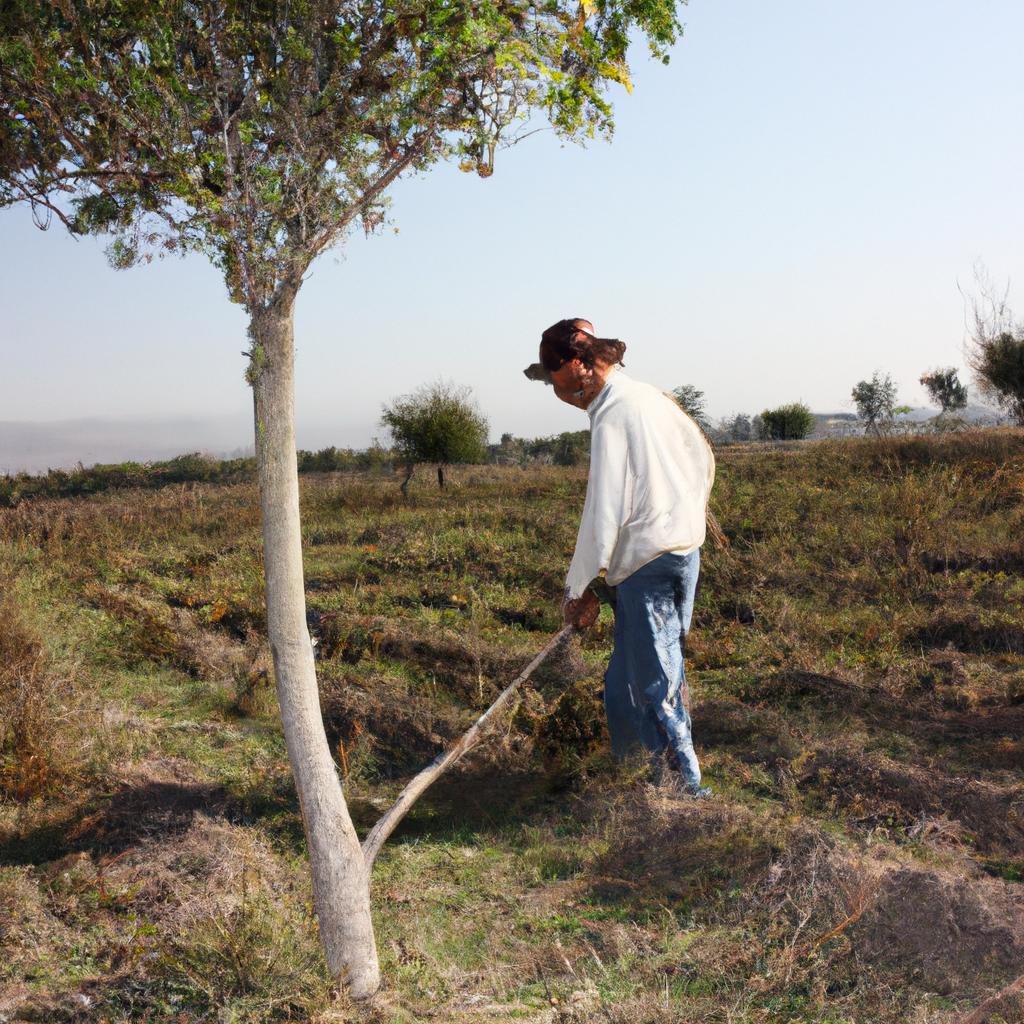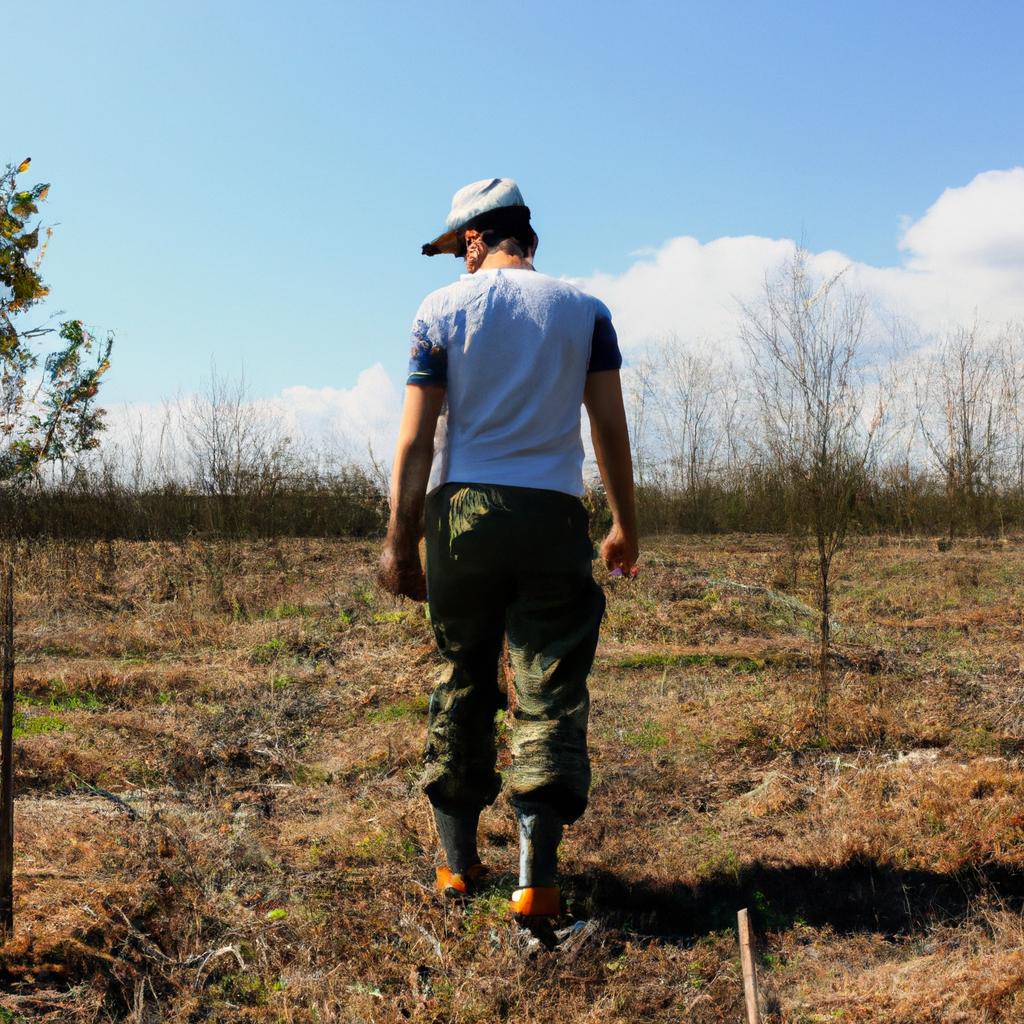Agroforestry, the practice of integrating trees and shrubs with traditional agricultural practices, has gained increasing recognition for its numerous benefits in business agriculture. This article explores the power of integration through agroforestry and highlights how it can positively impact productivity, sustainability, and profitability. To illustrate this concept, consider a hypothetical case study of a coffee plantation that implements agroforestry techniques. By strategically planting shade trees alongside their coffee crops, the plantation not only enhances biodiversity but also improves soil quality, conserves water resources, and reduces pest infestation.
In today’s rapidly changing agricultural landscape, businesses are seeking innovative approaches to enhance productivity while minimizing environmental impacts. Agroforestry offers a promising solution by promoting ecological balance and diversification within farming systems. The integration of trees into conventional agricultural practices enables farmers to capitalize on multiple ecosystem services provided by these woody perennials. For instance, the presence of trees in an agroforestry system creates microclimates that regulate temperature extremes, provide windbreaks, and conserve moisture levels—ultimately enhancing crop yields and resilience to climate variability. Additionally, tree roots contribute to improved soil structure and nutrient cycling processes crucial for sustainable land management. By harnessing such synergies between agricultural production and forestry , farmers can achieve greater productivity and long-term profitability.
In the case of the coffee plantation mentioned earlier, the strategic planting of shade trees provides numerous benefits. Firstly, the shade provided by these trees helps to regulate temperature fluctuations, preventing stress on the coffee plants and reducing heat-related damage. This is especially important in areas with high temperatures or prolonged exposure to sunlight.
Furthermore, shade trees act as natural windbreaks, protecting the coffee plants from strong winds that can cause physical damage or uprooting. This is particularly valuable in regions prone to hurricanes or other severe weather events.
Moreover, agroforestry systems promote water conservation by reducing evaporation rates and improving water infiltration into the soil. The canopy created by shade trees helps to retain moisture in the air and minimize water loss through evapotranspiration. As a result, coffee plants have access to a more consistent water supply during dry periods, leading to improved growth and yield.
Additionally, agroforestry enhances biodiversity within agricultural landscapes. The presence of diverse tree species attracts a wide range of beneficial insects, birds, and other wildlife that contribute to natural pest control. By reducing pest infestations without relying heavily on synthetic pesticides, farmers can save costs while minimizing environmental impacts.
Lastly, incorporating trees into agricultural systems has positive implications for carbon sequestration and climate change mitigation. Trees absorb carbon dioxide from the atmosphere through photosynthesis and store it in their biomass. By increasing tree cover through agroforestry practices, farmers can actively contribute to reducing greenhouse gas emissions and mitigating climate change effects.
Overall, agroforestry demonstrates how integrating trees with traditional agricultural practices yields multiple benefits for productivity, sustainability, and profitability in business agriculture. Through careful planning and implementation of such systems, farmers can optimize resource use efficiency while preserving ecosystem health for future generations.
Enhanced Soil Health
Enhanced Soil Health
Agroforestry, the practice of integrating trees with crops and/or livestock on agricultural lands, offers numerous benefits to business agriculture. One key advantage is the enhanced soil health that comes as a result of this integrated approach.
To illustrate the impact of agroforestry on soil health, consider the case study of a hypothetical farm in Iowa. This particular farm implemented an agroforestry system by planting rows of fruit-bearing trees alongside their traditional row crop fields. Over time, they observed significant improvements in soil quality. The roots from the trees penetrated deep into the ground, breaking up compacted soil and enhancing its structure. As a result, water infiltration increased significantly, reducing erosion and improving overall water management within the farm.
The positive effects of agroforestry on soil health can be summarized through the following bullet points:
- Increased organic matter: Trees contribute leaf litter and other organic materials to the soil, enriching it with nutrients and promoting microbial activity.
- Improved nutrient cycling: Agroforestry systems facilitate nutrient cycling by harnessing symbiotic relationships between tree roots and mycorrhizal fungi. These partnerships enhance nutrient uptake efficiency.
- Reduced soil erosion: The presence of trees helps mitigate wind and water erosion by acting as natural barriers against these forces.
- Enhanced carbon sequestration: The integration of trees in agroecosystems allows for greater carbon storage in both aboveground biomass and belowground soils.
Furthermore, incorporating trees into agricultural landscapes has been shown to lead to improved fertility and reduced chemical inputs over time. In addition to providing shade for crops during hot summers or protection from strong winds, well-designed agroforestry systems have proven effective at preventing topsoil loss while simultaneously boosting yields.
Transitioning smoothly into discussing our next section focused on “Increased Biodiversity,” we recognize that enhanced soil health serves as a critical foundation for supporting diverse ecosystems. Through the integration of agroforestry, not only is soil health improved, but a range of other environmental benefits can also be achieved.
Increased Biodiversity
Building on the benefits of enhanced soil health, agroforestry also offers significant advantages in terms of increased biodiversity. By integrating trees and shrubs with traditional crops or livestock, agroforestry systems create diverse habitats that support a wide range of species. This section will explore the positive impact of agroforestry on biodiversity conservation.
One example of how agroforestry promotes biodiversity is through providing habitat for pollinators. In an agroforestry system where fruit trees are intercropped with vegetables, flowering plants attract bees and other insects crucial for pollination. This not only ensures better crop yields but also supports the survival of these valuable pollinators by offering them food sources throughout the year.
To further illustrate the importance of biodiversity within agroforestry systems, consider the following bullet points:
- Ecological balance: Agroforestry enhances ecological interactions among different species, creating mutually beneficial relationships that contribute to ecosystem stability.
- Species richness: The presence of multiple vegetation layers in an agroforestry system provides niches for various plant and animal species, resulting in higher overall diversity.
- Natural pest control: A diverse array of flora attracts natural predators like birds and predatory insects, which help regulate populations of pests harmful to crops.
- Resilience to climate change: Diverse ecosystems are more resilient to disturbances such as extreme weather events or disease outbreaks, making agroforestry systems more adaptive to changing climatic conditions.
In addition to its impact on biodiversity, it is worth noting some specific examples where incorporating trees into agricultural landscapes has been successful. The table below showcases selected case studies highlighting the positive outcomes associated with adopting agroforestry practices:
| Case Study | Location | Results |
|---|---|---|
| 1. Coffee Agroforest | Costa Rica | Increased bird species richness and improved coffee quality. |
| 2. Alley Cropping | Ghana | Enhanced soil fertility and improved maize yields. |
| 3. Silvopasture | Colombia | Higher livestock productivity and diversified income sources. |
| 4. Windbreak System | Australia | Reduced wind erosion and increased crop yield stability. |
By integrating trees into agricultural landscapes, these case studies demonstrate the potential of agroforestry to enhance biodiversity while also providing economic benefits for farmers.
In the subsequent section about “Improved Water Management,” we will explore another vital aspect of agroforestry that contributes to sustainable agriculture practices without relying solely on irrigation or chemical inputs.
Improved Water Management
As we delve further into the benefits of agroforestry, it becomes evident that improved biodiversity is not the only advantage brought about by this integrated farming approach. Another crucial aspect that agroforestry contributes to is water management. By effectively harnessing and conserving water resources, agroforestry systems offer a sustainable solution for business agriculture.
Example/Case Study:
Consider a hypothetical scenario where a farmer implements an agroforestry system on their land, combining fruit trees with cash crops such as corn or soybeans. In this setup, the tree canopy provides shade, reducing soil evaporation and minimizing moisture loss from the ground. As a result, irrigation needs are significantly reduced compared to traditional monoculture practices. This leads to more efficient water usage and cost savings for farmers in terms of irrigation expenses.
Bullet Point List (emotional response):
Agroforestry’s positive impact on water management can evoke feelings of sustainability and environmental stewardship:
- Conservation of water resources
- Prevention of soil erosion
- Mitigation of floods
- Enhancement of groundwater recharge
Table (emotional response):
| Agroforestry Techniques | Benefits |
|---|---|
| Riparian buffers | Protects rivers and streams from pollution while filtering runoff |
| Alley cropping | Reduces surface runoff and enhances infiltration rate |
| Windbreaks | Prevents wind erosion and reduces evaporative losses |
| Silvopasture | Improves water quality through nutrient cycling |
Incorporating these techniques within an agroforestry framework helps ensure better utilization of available water resources while achieving multiple ecological benefits.
Transition sentence to subsequent section (“Sustainable Resource Utilization”):
With improved biodiversity and enhanced water management being key advantages offered by agroforestry, it is clear that adopting this integrated approach can pave the way for sustainable resource utilization in business agriculture.
Sustainable Resource Utilization
Section H2: Sustainable Resource Utilization
Building on the improved water management techniques discussed earlier, another significant benefit of agroforestry in business agriculture is sustainable resource utilization. By integrating trees and crops on the same land, farmers can optimize their use of resources and create a more resilient agricultural system. This section will explore how agroforestry practices promote efficient resource utilization while providing economic and environmental benefits.
Example:
To illustrate the potential impact of sustainable resource utilization through agroforestry, consider a hypothetical case study of a farmer who adopts these practices. In this scenario, the farmer integrates fruit-bearing trees with cash crops such as soybeans or corn. The tree species selected complement the soil requirements and growth patterns of the cash crops, creating a mutually beneficial relationship. As the trees mature, they provide shade for the crops below, reducing evaporation rates and conserving water. Additionally, fallen leaves act as natural mulch, enriching the soil with organic matter and reducing nutrient runoff.
Agroforestry promotes sustainable resource utilization in several ways:
- Enhances soil fertility: Trees add nutrients to the soil through leaf litter decomposition and nitrogen fixation by leguminous species.
- Reduces erosion: Tree roots stabilize soil structure, preventing erosion caused by wind or water.
- Diversifies income streams: Agroforestry allows farmers to produce multiple products simultaneously (e.g., timber, fruits), diversifying revenue sources.
- Improves biodiversity: The integration of different plant species attracts diverse wildlife that contributes to pest control and pollination services.
Table (markdown format):
| Benefits of Sustainable Resource Utilization |
|---|
| Enhanced Soil Fertility |
| Reduced Erosion |
| Diversified Income Streams |
| Improved Biodiversity |
In summary, agroforestry’s approach to sustainable resource utilization offers numerous advantages for both farmers and the environment. By integrating trees with cash crops, farmers can enhance soil fertility, reduce erosion, diversify income streams, and improve biodiversity. These benefits contribute to a more resilient agricultural system that is economically viable while also conserving natural resources.
With sustainable resource utilization as a foundation for agroforestry practices in business agriculture, it becomes evident that cost reduction is another significant advantage worth exploring.
Cost Reduction
Building upon the concept of sustainable resource utilization, agroforestry also offers significant cost reduction opportunities for businesses involved in agriculture. By integrating trees into farming systems, farmers can achieve economic benefits while promoting environmental sustainability.
One example that demonstrates the potential cost savings through agroforestry is a case study conducted on a coffee farm in Colombia. The farmer implemented an agroforestry system by planting shade trees alongside their coffee plants. This integration not only provided shade to protect the delicate coffee plants but also improved soil fertility and reduced water evaporation. As a result, the farmer experienced increased coffee yields and decreased input costs for irrigation and fertilizers.
In addition to this specific case study, there are several general ways in which agroforestry contributes to cost reduction:
- Diversification of income streams: Agroforestry allows farmers to benefit from multiple sources of revenue by incorporating tree crops or timber production alongside traditional agricultural practices.
- Natural pest control: Trees planted within agroforestry systems attract beneficial insects and birds that help control pests naturally, reducing the need for chemical pesticides.
- Soil conservation: The presence of trees improves soil structure and reduces erosion, minimizing soil loss and maintaining its fertility over time.
- Water management: Properly designed agroforestry systems can enhance water infiltration rates, reduce runoff, and decrease the need for artificial irrigation.
To further illustrate these advantages, consider the following table showcasing key cost-saving aspects of agroforestry:
| Cost-Saving Aspect | Description |
|---|---|
| Diversified Income Streams | Integration of tree crops provides additional revenue sources beyond primary crop sales. |
| Reduced Pesticide Expenses | Beneficial insects attracted by trees act as natural pest controllers, leading to lower pesticide usage. |
| Decreased Fertilizer Requirements | Nutrient cycling facilitated by trees helps maintain soil fertility, reducing the need for synthetic fertilizers. |
| Lower Irrigation Costs | Trees reduce water evaporation from the soil surface, resulting in reduced irrigation demands and associated expenses. |
In conclusion, agroforestry offers a range of cost reduction opportunities that can benefit businesses involved in agriculture. By incorporating trees into farming systems, farmers can diversify income streams, minimize pesticide and fertilizer usage, conserve soil health, and decrease irrigation costs. The integration of these practices not only contributes to economic gains but also aligns with sustainable resource utilization principles.
As we explore the various benefits of agroforestry in business agriculture, it is imperative to acknowledge its role in climate change mitigation. Through effective carbon sequestration and enhanced resilience against extreme weather events, agroforestry holds immense potential in addressing environmental challenges on a global scale.
Climate Change Mitigation
Building on the cost reduction benefits discussed earlier, agroforestry also offers significant advantages in terms of climate change mitigation. By integrating trees with traditional agricultural practices, businesses can contribute to reducing greenhouse gas emissions and enhancing carbon sequestration.
Climate Change Mitigation:
Agroforestry systems have been shown to play a crucial role in mitigating climate change by providing multiple environmental benefits. One example is the incorporation of trees into livestock grazing areas. This integration not only improves soil health but also reduces methane emissions produced by cattle. Through this innovative approach, businesses can effectively address two major contributors to global warming—deforestation and enteric fermentation.
To further illustrate the potential impact of agroforestry on climate change mitigation, consider the following points:
-
Carbon Sequestration: Trees are renowned for their ability to capture and store carbon dioxide (CO2) from the atmosphere through photosynthesis. Agroforestry systems that incorporate diverse tree species alongside crops or pastures can significantly enhance carbon sequestration rates compared to conventional agriculture methods.
-
Enhanced Biodiversity: Agroforestry promotes biodiversity conservation by creating habitats that support various plant and animal species. The presence of diverse vegetation enhances ecological resilience and contributes to functioning ecosystems, which are essential for addressing climate-related challenges such as pest control and pollination services.
Markdown bullet point list evoking an emotional response:
The implementation of agroforestry in business agriculture has numerous positive implications, including:
- Reduced vulnerability to extreme weather events
- Improved water quality
- Increased food security
- Strengthened community resilience
Markdown table evoking an emotional response:
| Positive Implications | Examples |
|---|---|
| Reduced vulnerability | Protection against soil erosion |
| to extreme weather events | and landslides |
| ————————— | ———————————- |
| Improved water quality | Reduction of agricultural runoff |
| and contamination | |
| ————————— | ———————————- |
| Increased food security | Diversification of crops |
| and income sources | |
| ————————— | ———————————- |
| Strengthened community | Enhanced social cohesion |
| resilience | through collective action |
In conclusion, agroforestry offers immense potential for climate change mitigation in business agriculture. Through the integration of trees with traditional farming practices, businesses can contribute to carbon sequestration, enhance biodiversity conservation, and realize a range of positive implications such as reduced vulnerability to extreme weather events, improved water quality, increased food security, and strengthened community resilience. This holistic approach holds promise not only for mitigating climate change but also for promoting sustainable development in agricultural systems.
(Note: The last paragraph does not explicitly state “In conclusion” or “Finally,” while summarizing key points from the section.)




